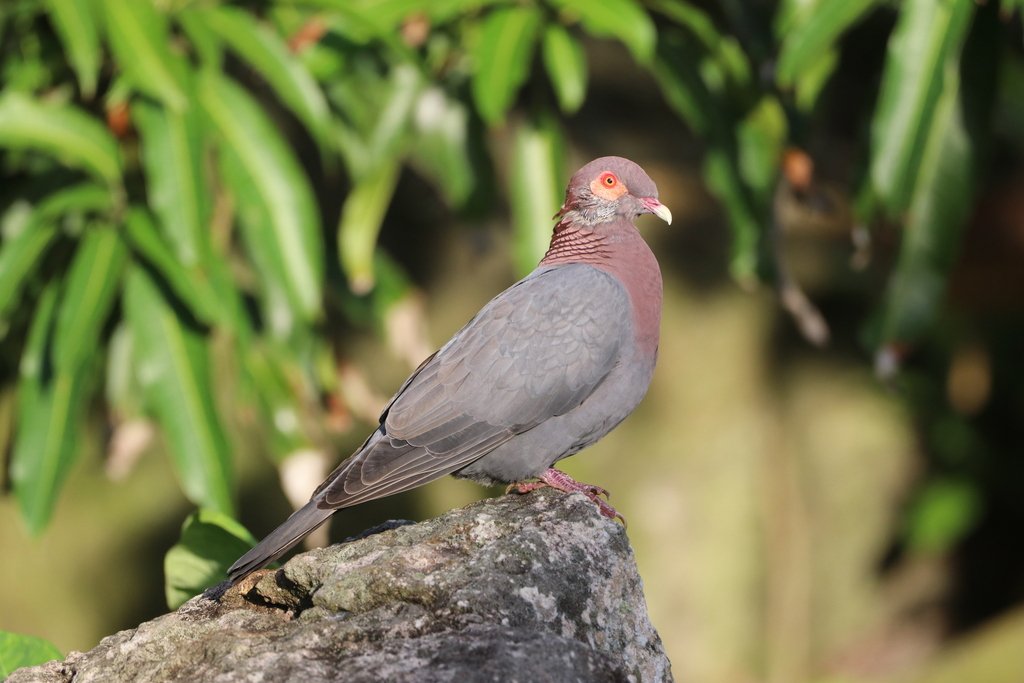In the Air: Birds
Scaly-naped pigeon
Patagioenas squamosa
Jumplinks:
About
Far from your typical city pigeon, the beautiful scaly-naped pigeons are common in the canopies of Saba’s forests. These large birds are important both ecologically and as a part of the island's soundscape. From the moment you arrive, whether it’s at the airport or the harbor, you’re sure to hear the resonant woo hooooo of the scaly-naped pigeon among the chorus of bird calls. Distinguishable from Saba’s other pigeons by its navy-blue body, maroon head, a bare patch of orange facial skin, red eyes, and a namesake cluster of patterned feathers on the back of its neck, these pigeons are consummate fruit-eaters on the island. Cherries, soursop, guava, and other edible fruits are all on the menu.
Many plants on Saba depend on birds like the scaly-naped pigeon to disperse their seeds, so that the next generation of fruiting trees aren’t competing with their parents for sunlight and other resources. Seeds ingested by scaly-naped pigeons get a temporary pair of wings to move around the island before being excreted and beginning their new life in a pile of natural fertilizer. All in all, these birds are some of the most prolific gardeners on the island.
To see a scaly-naped pigeon for yourself, keep an ear out and look to the tops of trees. Since they tend to hang out high in the canopy, they’re often heard before they’re seen, though on Saba you can use the many mountains and hills to your advantage. If you can get up high and look down on the tree tops, you may even get a glimpse of one of their nests — loose platforms made of sticks and mosses that are used for only about five weeks. That’s the amount of time it takes their young to incubate, hatch, and fledge the nest to become Saba’s next generation of cooing, gardening, scaly-naped, do-it-all pigeons.
Header image by @zahnerphoto (CC-BY-NC).
This species is:
Native
Why that matters:
Native species are those that evolved in the region naturally, without human influence. That means they’re specifically adapted to Saba’s habitat, and play a key role in island biodiversity. When we lose native species, gaps appear in the ecosystem. That leads to cascades of additional extinctions, and to the loss of the ecosystem services (food, clean air and water, flood and coastal protections, and more) that we humans rely on.
iNaturalist Observations
Where locals, researchers, and visitors have seen this species.
Google / Imagery © 2023 CNES / Airbus, Landsat / Copernicus, Maxar Technologies, U.S. Geological Survey, iNaturalist Map data @2023
This map shows geotagged observations of this species made on iNaturalist, the world’s largest community-science platform.
iNat depends on people like you. By uploading photos of species you see in the wild, you can easily learn more about them — while also contributing critical data used by scientists and conservation-managers around the globe.
See something odd?
Observations of land species in water:
Connectivity can affect how accurate location services are, and in the case of endangered species, location is often automatically obscured.Missing observations:
Your help is needed to collect more data for this species!
Ask a Scientist
Question: Why are islands hotspots of unique or endemic biodiversity?
Answer: The classic idea of how evolution happens on islands is what we call “allopatric speciation,” which means when you move to an island and are no longer interbreeding with other populations, you can wander down your own evolutionary path — and eventually you’ll become different enough to become a new species. Sometimes those changes are adaptations, but sometimes it’s more random.
Dr. Jack Dumbacher
Curator of Ornithology & Mammalogy, California Academy of Sciences
Related Content
Bridled quail-dove
In the Air: Birds
Soursop
On Land: Plants









